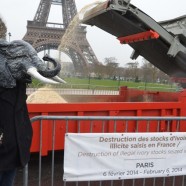“On the Trail” n°4
Here now the 4th edition of « On the Trail »
Information and analysis bulletin on animal poaching and smuggling.
1st January – 31th March 2014.
112 pages, 468 events, 352 information sources.
Rhinoceroses and elephants, pages 62 to 90
All dials are in the red. On the endangered species market prices are soaring. China and the world exotic pet trade are weighing heavily. The red-fronted parrot in Congo smuggled by Blue Helmets are sold for 800 US$ on Internet. Rhino horns reach 100,000 US$/kg, leopard skin more than 30,000 US/$. Mumbai golden youth gets high on cobra venom (180,000 US$/l). Isilo, the elephant who became a symbol of South Africa, is dead. His 2 tusks worth 600,000 US$ have disappeared. Poachers were the first to find his body by spotting the vultures. Suspicion lingers. Daytime rangers become night-time poachers. Prices go wild, the violence does also. Animals, thieves and rangers fall. Traffickers kill each other like traffickers of a drug cartel. Gangs rule, gangrene thrives. This is war. Justice is incoherent. From severe punishment to set an example to a mere bail, justice sometimes goes astray. Traffickers are often very young. Poachers ride BMWs. Killing methods are both modern and archaic.
(Français) L’interdiction du commerce de l’ivoire est indispensable pour sauver les éléphants
“On the Trail” n°3
Quarterly information and analyses bulletin on animal poaching and smuggling (pdf 80 p. 4.5 Mo) with a special item on the scheduled French illegal ivory crushing tomorrow.
Rhinoceroses and elephants, pages 48 to 69
Here’s to China for the Elephants!
Today, China destroyed some of the stockpiles of illegal elephant ivory seized along and within its borders.
In accordance with CITES* Decisions, the traders accredited by the Chinese government bought, at auctions, 60 tonnes of ivory in 2008 from 4 countries in southern Africa, Zimbabwe, Botswana, Namibia, and South Africa. The average price was 157 US$/kg, ten times less expensive than black market rates at the time. Following this 172 workshops and retail stores were supplied elephant tusks benefiting from a specific license.
French Ivory to be Scrapped
Robin des Bois has been officially requesting for over 6 months that the French Government proceed to the destruction of illegal ivory accumulated over several decades and for an inventory of stockpiles to be made public.
After some hesitation, France has finally decided to go through with this destruction. An inventory of storage places and quantities held is in the making. It will include Court registries, Natural History Museums and border police storage facilities. Total amounts could reach several tens of tons. Only a few pieces of ivory are to be kept for scientific and pedagogical reasons.
Secret Tusks
Today, the United States destroyed 5.4 tons of ivory that has been seized over the last 25 years by authorities enforcing national and international regulations. An official notification has been sent to the secretariat of CITES (Convention on International Trade in Endangered Species of Wild Fauna and Flora). The United States hopes that other states will also destroy their illegal ivory stockpiles.
They cannot count on France to do so. In a recent letter to Robin des Bois, the Minister of Ecology expressed his belief that countries undertaking the willful destruction of ivory seizures are emphasizing symbolic and high-profile action at the expense of actual substantive measures. In addition, the Ministry of Ecology refuses, “for security reasons”, to publicize an inventory of the stock of illegal ivory held by the French State and the museums of Natural History.
“On the Trail” n°2
Take a trip of beauty and cruelty in the following 80 pages (pdf. 4Mo), swing through the trees with the supreme pleated gibbon, still at liberty in the wild despite being endangered, get to the bottom of cyanide and of poisoned pineapples, survive the etorphine laced arrows, scheme with furniture dealers looking for ivory, discover the cunning tiger trappers, hunt down blackbucks with Bollywood stars, cruise towards China with 2,000 saiga antelope horns worth 22 million dollars, look into the eyes of a baby chimpanzee in a pathetic plastic bag at a Cameroon market, entrench yourselves in the fate of thousands of birds and animals unwilling migrants forcefully removed from their habitats, float down a river with a mutilated elephant carcass and find out about France’s stance on the future of illegal ivory stockpiles, eat Ganges river dolphin meat, pay homage to rangers and forest guards murdered in the wild by poachers …
Rhinoceroses and elephants, pages 42 to 69
Obama, Hollande and Elephants
Since early September the United States announced that they would carry out on October 8 the destruction of 5.4 tonnes of illegal ivory confiscated over the last 25 years on their soil. This destruction is in line with an Executive Order by President Obama on July 1, 2013 on Combating Wildlife Trafficking. In this light the United States has launched a national and international programme aimed at stopping “slaughter commissioned by armed and organized criminal Syndicates.” This constitutes a formidable task.
India Burns Smuggled Ivory. And France?
Today, the state of Maharashtra will burn precious animal materials that have been seized by anti-poaching organizations. The leopard and tiger fur that was priced at about €12,000 a piece, along with the tusks of ivory that are sold on the black market from €1,500/kg for up to €5,500/kg, will be completely destroyed.
The state of Kerala is getting ready to do the same with their stock of 3 tons of ivory that has been seized over the past 20 years.
The Indian authorities will be taking advantage of the widespread presence of spectators to raise awareness, thereby doubling their efforts in the fight against environmental crime by enforcing both International regulations and Indian law for the protection of animals.











